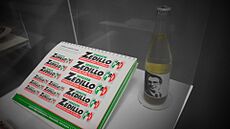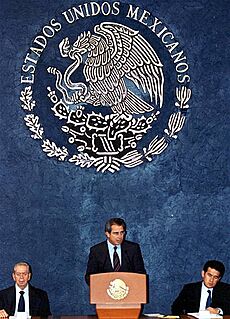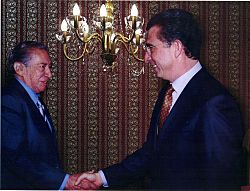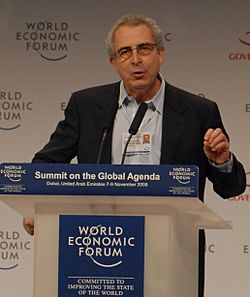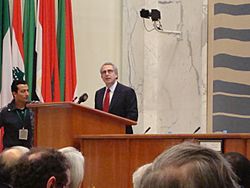Ernesto Zedillo facts for kids
Quick facts for kids
Ernesto Zedillo
|
|
|---|---|
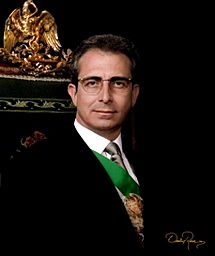
Official portrait, 1999
|
|
| 61st President of Mexico | |
| In office 1 December 1994 – 30 November 2000 |
|
| Preceded by | Carlos Salinas de Gortari |
| Succeeded by | Vicente Fox |
| Secretary of Public Education | |
| In office 7 January 1992 – 29 November 1993 |
|
| President | Carlos Salinas de Gortari |
| Preceded by | Manuel Bartlett |
| Succeeded by | Fernando Solana |
| Secretary of Programming and Budget | |
| In office 1 December 1988 – 31 December 1991 |
|
| President | Carlos Salinas de Gortari |
| Preceded by | Pedro Aspe |
| Succeeded by | Rogelio Gasca |
| Personal details | |
| Born |
Ernesto Zedillo Ponce de León
27 December 1951 Mexico City, Mexico |
| Political party | Institutional Revolutionary Party |
| Spouse |
Nilda Patricia Velasco
(m. 1974) |
| Children | 5 |
| Parents | Rodolfo Zedillo Castillo Martha Alicia Ponce de León |
| Residences | Mexico City New Haven, Connecticut, U.S. |
| Education | National Polytechnic Institute (BA) Yale University (MA, PhD) |
| Signature |  |
Ernesto Zedillo Ponce de León (born 27 December 1951) is a Mexican economist and politician. He served as the 61st president of Mexico from 1994 to 2000. He was the last president from the Institutional Revolutionary Party (PRI) after 71 years of their continuous rule. Zedillo is known for helping Mexico move towards a more open democracy.
During his time as president, Mexico faced a very difficult economic crisis. This crisis began just weeks after he took office. He also continued some economic policies from previous presidents. His presidency also saw challenges with groups like the EZLN. There were also sad events like the Aguas Blancas and Acteal massacres.
Even though his policies helped the economy recover, many people were tired of the PRI party. In 1997, the PRI lost its majority in the legislature for the first time. Then, in the 2000 Mexican general election, Vicente Fox from the National Action Party won the presidency. This ended the PRI's long rule. Zedillo accepted the defeat peacefully and handed over power. This action improved his public image.
Since leaving office, Zedillo has become an important voice on global issues. He works at Yale University and is involved with several international organizations.
Contents
Early Life and Education
Ernesto Zedillo Ponce de León was born on 27 December 1951 in Mexico City. His father, Rodolfo Zedillo Castillo, was a mechanic, and his mother was Martha Alicia Ponce de León. His parents moved to Mexicali, Baja California, hoping to find better jobs and schools for their children.
In 1964, when he was 13, Zedillo returned to Mexico City. In 1969, he started studying at the National Polytechnic Institute. He paid for his studies by working at a bank. He graduated as an economist in 1972 and began teaching. He met his wife, Nilda Patricia Velasco, among his first students. They have five children together.
In 1974, he went to Yale University for his master's and PhD degrees. His doctoral paper was about Mexico's national debt and its connection to oil.
Starting a Political Career
Zedillo began working at the Bank of Mexico, which is Mexico's central bank. He was a member of the Institutional Revolutionary Party (PRI). He helped create economic plans to improve the country. By 1987, he became a deputy secretary in the Secretariat of Budget and Planning. In 1988, at 38, he became the head of that department. During this time, he started a reform for science and technology.
In 1992, President Carlos Salinas appointed him Secretary of Education. In this role, he was in charge of reviewing public school textbooks. Some changes he made were controversial, and the textbooks were later removed. A year later, he left this job to help with the presidential campaign of Luis Donaldo Colosio, the PRI's candidate.
1994 Presidential Campaign
In 1994, after Colosio was sadly assassinated, Zedillo became the new presidential candidate for the PRI. He was one of the few PRI members who could take Colosio's place under Mexican law.
Many people blamed the previous president, Salinas, for Colosio's death. Colosio had given a speech during his campaign where he talked about Mexico's problems. This speech was seen by some as a reason for a disagreement between him and President Salinas. Also, Colosio had visited the Zapatista movement and promised to talk with them, which the PRI did not support.
Zedillo ran against Diego Fernández de Cevallos and Cuauhtémoc Cárdenas. He won the election with 48.69% of the votes. He became the last president from the PRI party to serve in the 20th century, ending their 70-year rule.
Presidency (1994–2000)
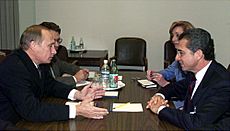
Ernesto Zedillo became president on 1 December 1994, at the age of 42. His election was seen as fair. However, he was a surprise candidate and did not have much political experience. Early in his presidency, there were rumors that he might resign, which caused some worry in the financial markets.
Dealing with Economic Challenges
Just a few days after Zedillo became president, Mexico faced a huge economic crisis. This crisis is often called the "Mexican peso crisis." Zedillo decided to lower the value of the Mexican peso, which caused a lot of financial problems. The crisis was very difficult for the country. To help, the U.S. president, Bill Clinton, gave Mexico a large loan of US$20 billion. This loan helped Zedillo's government rescue the banking system and start to fix the economy.
Showing Independence
Zedillo wanted to show that he was truly in charge and not controlled by the previous president, Carlos Salinas. To do this, on 28 February 1995, Zedillo ordered the arrest of Salinas's older brother, Raúl Salinas. This action clearly showed that Zedillo was making his own decisions as president.
Addressing the Zapatista Conflict
Mexico had been dealing with unrest since January 1994, especially with the Zapatista rebellion. The Zapatistas were a group in Chiapas who wanted more rights for indigenous people. President Zedillo's government tried to handle this situation.
In early 1995, the government started secret talks with the Zapatista leader, Subcomandante Marcos. These talks aimed to find a peaceful solution. The government also identified Marcos as Rafael Sebastián Guillén, a former professor. This was an attempt to show he was not just an indigenous leader. The government and the Zapatistas eventually signed the San Andrés Accords in February 1996, which were agreements for peace.
Helping Families in Need
Zedillo's main goal as president was "Well-being for your family." He created a program called Progresa. This program gave money to the poorest families in Mexico. To receive the money, children in these families had to go to school. This program was later renamed Oportunidades and continued to help many families.
Trade and Economic Changes
Zedillo was the first president to oversee the NAFTA for his entire term. NAFTA is a trade agreement between Mexico, the U.S., and Canada. Even though the economy faced challenges early on, there were hopes that NAFTA would help Mexico's economy grow.
During his presidency, Zedillo also privatized the state railway company, Ferrocarriles Nacionales de México. This meant that private companies took over the railways. As a result, passenger train service was stopped in 1997.
Changes to Elections
Zedillo believed that changing the election rules was very important. In 1995, he started talks with different political parties about how to make elections fairer. In 1996, these talks led to new rules that were approved by the Mexican Congress.
These changes created independent organizations to oversee elections. They also made the position of Head of Government of Mexico City an elected role, instead of being appointed. These reforms reduced the power of the PRI party and gave other parties a better chance. In the 1997 elections, the PRI lost its majority in Congress for the first time ever.
International Relations
Zedillo worked to build new relationships with countries around the world, including China. He also successfully completed talks for a Free Trade Agreement with the European Union, which started in July 2000.
Public Opinion
Zedillo's approval ratings were unusual. Most presidents are very popular when they first take office. However, Zedillo's popularity dropped quickly after the economic crisis in December 1994. His approval rating was very low in early 1995.
However, his approval ratings began to grow steadily from January 1997. This was helped by the economy getting better and his peaceful transfer of power to Vicente Fox. Zedillo left office with a high approval rating of 64%. On average, his approval rating during his presidency was 55.3%.
2000 Election
The presidential election on 2 July 2000 was a very important moment in Mexican history. For the first time, the PRI presidential candidate was not chosen by the sitting president. Instead, the party held an open primary election. New election rules also meant that the government no longer controlled the voting process. The Federal Electoral Institute (IFE), an independent body, was in charge of ensuring fair elections.
The results of this election were historic. For the first time since the PRI party was founded in 1929, a candidate from an opposition party won. This was a peaceful change from a long period of one-party rule. When the polls closed, Zedillo went on national television and announced that Vicente Fox had won. This action showed Zedillo's commitment to democracy.
After the Presidency
Since leaving office, Zedillo has worked as an economic consultant for many international companies and organizations. He teaches economics at Yale University and leads the Yale Center for the Study of Globalization. He has also been involved in discussions about global climate change.
Working with Organizations
Zedillo serves on the boards of directors for several large companies, including Citigroup and Alcoa. He is also a member of many non-profit organizations. These include the Kofi Annan Foundation, which works on elections and democracy, and The Elders, a group of global leaders working for peace and human rights.
In 2020, he joined an independent group called the Independent Panel for Pandemic Preparedness and Response (IPPR). This group looked at how the World Health Organization (WHO) and different countries handled the COVID-19 pandemic.
Honors and Awards
Mexican Honors
- Collar of the Order of the Aztec Eagle (1996)
International Honors
- Argentina: Grand Collar of the Order of the Liberator General San Martín (1996)
- Estonia: Collar of the Order of the Cross of Terra Mariana (1995)
- Spain: Collar of the Order of Isabella the Catholic (1996)
- Italy: Knight Grand Cross with Collar of the Order of Merit of the Italian Republic (1996)
- Uruguay: Medal of the Oriental Republic of Uruguay (1996)
- Peru: Grand Collar of the Order of the Sun of Peru (1996)
- Peru: Order of Merit for Distinguished Service (1996)
- Portugal: Grand Collar of the Order of Prince Henry (1998)
- United Kingdom: Honorary Knight Grand Cross of the Order of St Michael and St George (1998)
- Finland: Grand Cross of the Order of the White Rose of Finland (1999)
- Romania: Grand Cross with Chain of the Order of the Star of Romania (2000)
- Hungary: Grand Cross with Chain of the Order of Merit of the Republic of Hungary (2000)
- Ukraine: First Class of the Order of Prince Yaroslav the Wise
Images for kids
See also
 In Spanish: Ernesto Zedillo para niños
In Spanish: Ernesto Zedillo para niños
- List of heads of state of Mexico
- History of Mexico
- Politics of Mexico
- Cabinet of Ernesto Zedillo


